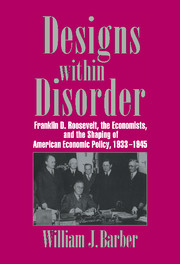 Designs within Disorder
Designs within Disorder Published online by Cambridge University Press: 11 September 2009
Roosevelt's decision to embark unapologetically on a “spend-lend” program in April 1938 appeared to signal that the administration had come to terms with an Americanized version of Keynesian aggregate demand management. This orientation toward macroeconomic policy making was solidified in early 1939. With a nudge from Marriner Eccles, the president urged a number of his cabinet officers to assist in selling “compensatory fiscal policy” to the public. As he put it:
We must present our case to the country. … For instance the Secretary of the Treasury could explain the soundness of the case. The Secretary of Commerce could do it with the aid of the more liberal members of the Business Advisory Council. The Secretary of Agriculture could do it with the objective of education of agricultural interests. The Secretary of the Interior could speak on the same subject from the angle of conserving material and human resources. … Economic soundness of the policy is already recognized by many economists and business men in this country .…
Meanwhile another vehicle for economic education was moving on a different track. The Temporary National Economic Committee (TNEC), with its charge to investigate the concentration of economic power, was off and running. Given its makeup, there was considerable uncertainty about what its activities would ultimately amount to. This body was, after all, an institutional hybrid. Half of its members were drawn from the Congress (three from the Senate, three from the House of Representatives), and six were appointed to represent executive departments and agencies.
To save this book to your Kindle, first ensure no-reply@cambridge.org is added to your Approved Personal Document E-mail List under your Personal Document Settings on the Manage Your Content and Devices page of your Amazon account. Then enter the ‘name’ part of your Kindle email address below. Find out more about saving to your Kindle.
Note you can select to save to either the @free.kindle.com or @kindle.com variations. ‘@free.kindle.com’ emails are free but can only be saved to your device when it is connected to wi-fi. ‘@kindle.com’ emails can be delivered even when you are not connected to wi-fi, but note that service fees apply.
Find out more about the Kindle Personal Document Service.
To save content items to your account, please confirm that you agree to abide by our usage policies. If this is the first time you use this feature, you will be asked to authorise Cambridge Core to connect with your account. Find out more about saving content to Dropbox.
To save content items to your account, please confirm that you agree to abide by our usage policies. If this is the first time you use this feature, you will be asked to authorise Cambridge Core to connect with your account. Find out more about saving content to Google Drive.